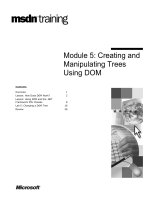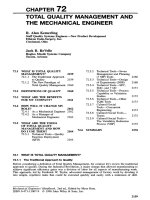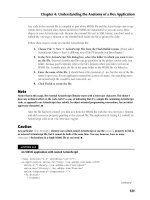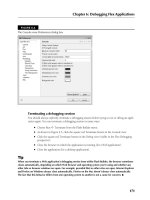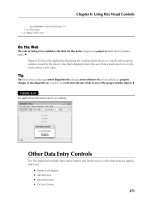Tài liệu Child mental health and educational attainment: multiple observers and the measurement error problem ppt
Bạn đang xem bản rút gọn của tài liệu. Xem và tải ngay bản đầy đủ của tài liệu tại đây (416.46 KB, 37 trang )
8
David Johnston
Monash University
Carol Propper
Imperial College and University of Bristol
Stephen Pudney
Institute for Social and Economic Research
University of Essex
Michael Shields
Monash University and University of Melbourne
No. 2011-20
August 2011
ISER Working Paper Series
ER Working Paper Series
R Working Paper Series
Working Paper Series
orking Paper Series
king Paper Series
ng Paper Series
Paper Series
aper Series
er Series
Series
eries
es
www.iser.essex.ac.uk
ww.iser.essex.ac.uk
w.iser.essex.ac.uk
iser.essex.ac.uk
er.essex.ac.uk
.essex.ac.uk
ssex.ac.uk
ex.ac.uk
.ac.uk
c.uk
uk
Child mental health and educational
attainment: multiple observers and the
measurement error problem
Non-technical summary
Child mental health is an important social and economic issue, not only because of its
implications for the wellbeing of children, but also because mental health problems
have been linked with poor educational achievement and consequent lifetime
disadvantage.
However, research on child mental health is problematic, in part because of the
difficulty of observing and measuring a child’s state of development and mental
health. Research is typically based on either diagnostic data from a clinical setting, or
on large-scale surveys which ask parents or teachers to assess the child’s mental
health using a structured questionnaire. The former approach is generally based on
small unrepresentative groups and is hard to generalise to the wider population of
young people. The survey approach suffers from the problem of measurement error –
parents and teachers may not be accurate observers and reporters of the child’s
behaviour and mental state. More seriously, these non-expert observers may be not
only inaccurate but systematically so, either because they have only a partial picture
of the child’s behaviour or because they are subject to bias in some way.
We evaluate these problems by using unusually rich survey data which provide
assessments from parents, teachers and children themselves, together with an overall
expert assessment which approximates the clinical diagnostic process. We find
evidence that parents, teachers and children are all biased reporters of children’s
mental health but that, using expert quasi-diagnoses as a yardstick, teacher
assessments are the most reliable, with children’s the least so.
Standard statistical procedures for dealing with measurement error maintain an
assumption that observation by parents and teachers is possibly inaccurate but not
inherently unbiased. We show that these conventional methods significantly overstate
the adverse impact that mental health problems (emotional, behavioural and
hyperactivity disorders) have on educational attainment.
Child Mental Health and Educational
Attainment: Multiple Observers and the
Measurement Error Problem
David Johnston
Monash University
Carol Propper
Imperial College and University of Bristol
Stephen Pudney
University of Essex
Michael Shields
Monash University and University of Melbourne
This version: July 15, 2011
Abstract
We examine the effect of survey measurement error on the empirical relationship between
child mental health and personal and family characteristics, and between child mental health
and educational progress. Our contribution is to use unique UK survey data that contains
(potentially biased) assessments of each child’s mental state from three observers (parent,
teacher and child), together with expert (quasi-)diagnoses, using an assumption of optimal
diagnostic behaviour to adjust for reporting bias. We use three alternative restrictions to
identify the effect of mental disorders on educational progress. Maternal education and
mental health, family income, and major adverse life events, are all significant in explaining
child mental health, and child mental health is found to have a large influence on educa-
tional progress. Our preferred estimate is that a 1-standard deviation reduction in ‘true’
latent child mental health leads to a 2-5 months loss in educational progress. We also find a
strong tendency for observers to understate the problems of older children and adolescents
compared to expert diagnosis.
Keywords: Child mental health; Education; Strengths and Difficulties Questionnaire; Mea-
surement error
JEL codes: C30, I10, I21, J24
Contact: Steve Pudney, ISER, University of Essex, Wivenhoe Park, Colchester, CO4 3SQ,
UK; tel. +44(0)1206-873789; email
We are grateful to participants at the 2010 Melbourne Workshop in Mental Health and Wellbeing and the 2011 CeMMaP work-
shop in Survey Measurement and Measurement Error for valuable comments. Johnston and Shields would like to thank the
Australian Research Council for funding. Pudney’s involvement was supported by the European Research Council (project no.
269874 [DEVHEALTH]), with additional support from the ESRC Research Centre on Micro-Social Change (award no. RES-
518-285-001) and a Faculty Visiting Scholarship in the Department of Economics and Melbourne Institute at the University of
Melbourne.
1 Introduction
Childhood has become the focus of a growing body of research in economics concerned
with the closely-related concepts of children’s wellbeing, mental health and non-cognitive
skills. Much of this interest has been sparked by Heckman’s model of life-cycle human
capital accumulation, which contends that, independently of cognitive ability, a stock of ‘non-
cognitive skills’ are built up by streams of investment over the life course and determine a wide
range of life outcomes (Heckman, Stixrud and Urzua, 2006). A strong motivation for this
line of research comes from the belief that IQ or cognitive ability is much less malleable than
socio-emotional skills, particularly after the age of 10. From a policy perspective, this would
suggest that the returns to interventions targeted at non-cognitive skills are potentially much
higher than those focused on cognitive outcomes alone. For example, the Perry preschool
intervention program in the 1960s did not raise the IQ of participating children in a lasting
way, yet they went on to have better adult outcomes than the control group in a variety
of dimensions (Heckman et al., 2010). The inference that Perry succeeded because of its
impact on attention skills or antisocial behaviours, rather than cognitive ability, is one that
is supported by evaluations of more recent childhood interventions which tend to show much
larger effects on behaviour (of both parents and children) than on cognitive achievement
outcomes (Currie 2009).
Mental health conditions are much more common in childhood than most physical condi-
tions and a growing body of evidence suggests that prevalence is highest among children from
low-income backgrounds. While the relationship between non-cognitive skills and medical
conceptions of mental health is unclear (even though in practice they are often measured
using the same indicators, for example, Duncan and Magnuson, 2009), whether interpreted
as lack of non-cognitive skills or the existence of a mental health problem, a central con-
cern is the impact that these adverse childhood states have on the process of human capital
1
accumulation and the implications for the intergenerational transmission of economic ad-
vantage. It has been recognised recently that mental health conditions are potentially an
important channel through which parental socio-economic status influences the outcomes of
the next generation. For example, Currie and Stabile (2006, 2007) and Currie et al. (2010)
found significant impacts of hyperactivity on a range of later educational outcomes in US
and Canadian longitudinal data and shown the persistence of these effects. Evidence from
the medical literature is rather more mixed but also indicates the potential importance of
mental health problems (Duncan and Magnuson, 2009; Breslau et al., 2008, 2009).
A key issue in the empirical study of the impact of child mental health on child outcomes
is reliability of measurement. Two types of measure are common in the research literature.
Clinical diagnoses are used extensively in psychiatric research, but they have several draw-
backs: they are often only available for small, endogenously-sampled groups of children; they
identify relatively extreme and rare cases (affecting somewhere in the region of 5 to 10% of
children); and they are sensitive to differences in diagnostic practice, which may produce
surprising differences between apparently similar groups (for example, diagnosed attention
deficit and hyperactivity disorder (ADHD) rates in the US are double those in Canada).
Alternative measures derive from ‘screener’ questionnaires which can be completed quickly
by parents, teachers or the children themselves, in the context of large-scale sample surveys.
These screeners are designed specifically to identify the symptoms of clinical disorders and
are often used as a first step in diagnosing suspected cases – a high screening score being sug-
gestive of a recognised disorder, while lower scores reflect the incidence of symptoms among
the ‘normal’ population. These screener questionnaires are typically used in the surveys
that also include measures of later outcomes and so can be used to assess the relationship
between early mental health and later outcomes. Few data sources are available that give
both screening and diagnostic-type information for large representative samples.
2
Whatever type of information is used, measurement error is an important concern. But
is has received little attention in the literature on the consequences of child mental health.
There is a substantial body of research suggesting that adults’ assessments of their physical
health are prone to serious measurement error (for example, Butler et al. 1987; Mackenbach
et al., 1996; Baker et al., 2004; Lindeboom and van Doorslaer, 2004; Etile and Milcent, 2006;
Bago d’Uva et al., 2007; Jones and Wildman, 2008; and Johnston et al., 2009), and this
problem is likely to be magnified in the case of child mental health. Children may manifest
symptoms differently in different settings, perhaps showing deviant behaviour at school but
not at home (or vice versa). They may deny or minimise socially undesirable symptoms
when asked by parents or teachers. Informants may also have very different thresholds or
perceptions of what constitutes abnormal behaviour in children.
The availability of multiple measures is particularly helpful in dealing with measurement
error problems, but there is a strong possibility of observer-specific reporting bias. There is
evidence in the psychology and medical literatures of large disagreements between informants
in their assessment of children’s psychological well-being. For example, in a sample of US
children aged between 5 and 10, Brown et al. (2006) found that parents failed to detect half
of school-aged children considered to be seriously disturbed by their teachers. Youngstrom
et al. (2003) found that prevalence rates of comorbidity in a clinical sample ranged from
5.4% to 74.1%, depending whether ratings from parent, teacher, child or some combination
are used to classify the child. Goodman et al. (2000) suggest that parents are slightly better
at detecting emotional disorders than teachers but that the opposite is true for conduct and
hyperactivity disorders, while the self-assessments of children have less explanatory power
than parents or teachers. Johnston et al. (2010) show, also using data from the Survey of
Mental Health of Children and Young People in Great Britain, that estimates of the income
gradient in childhood mental health are sensitive to who provides the assessment, with the
3
smallest gradients found when using childrens own assessment of themselves rather than
those of parents and teachers.
A clear implication of this limited body of evidence is that measurement error is substan-
tial and unlikely to be the simple random noise which is assumed by the classical errors-in-
variables model. If no observer can be assumed to be unbiased, standard methods (such as
that of Hu and Schennach, 2008) cannot be used to identify the true mental health process.
In this paper we make two main contributions. First, we exploit data from a remarkable
UK survey (see Section 2) that contains assessments of children’s mental health from parents,
teachers and the children themselves, to demonstrate the existence of significant biases in all
three observers. We do this by using additional diagnostic-style assessments from a panel of
expert psychiatric assessors, under the assumption that the experts are able to make the best
possible use (in a rational expectations sense) of all available information, but with random
variations in the threshold of seriousness they use for generating diagnoses. This model of
expert behaviour, set out in Section 3, allows us to identify (up to scale) the parameters of
a model representing the distribution of ‘true’ child mental health conditional on personal
and family characteristics.
Second, we estimate the effect of mental health on educational progress. This requires us
to overcome a second identification problem, discussed in Section 4, arising from the difficulty
in distinguishing the indirect effect of influences on mental health from their direct effect on
educational attainment. We use alternative identification strategies to provide, in Section 5,
parallel estimates of the impact of mental health problems on educational progress, relative
to an age-specific norm. We show that if an orthodox multiple-indicator latent variable
model under the assumption of the existence of an unbiased observer is used, we would
reach the conclusion that mental disorders have an adverse impact roughly twice as large
as is suggested by a simple regression estimate based on the observable proxy for mental
4
health. However, two alternative (and preferable) instrumental variable strategies which do
not impose the simple assumption of an unbiased observer, give rather smaller estimates.
We find in this case they are also similar to those obtained from simple proxy regressions.
2 Data, Definitions and Descriptive Statistics
The data we use come from the 2004 Survey of Mental Health of Children and Young
People in Great Britain, commissioned by the Department of Health and Scottish Executive
Health Department, and carried out by the Office for National Statistics. Its aim was to
provide information about the prevalence of psychiatric problems among people living in
Great Britain, with a particular focus on three main categories of mental disorder: conduct
disorders, emotional disorders and hyperkinetic disorders. A sample of children aged between
5 and 16 years was randomly drawn using a stratified sample design (by postcode) from the
Child Benefit register. At the time of sampling, Child Benefit was essentially a universal
entitlement for parents of all children, so the register provides an excellent sampling frame.
Information was obtained in 76% (or 7,977) of sampled cases, yielding information gathered
from the child’s primary caregiver (the child’s mother in 94% of cases), from the teacher
and (if aged 11-16) the young person him/herself. Among co-operating families, almost all
the parents and most of the children gave full responses, while teacher postal questionnaires
were obtained for 78% of the children interviewed. We focus on a sub-sample of 6,808
white children who have information supplied by their mother, and who have non-missing
information for key covariates and mental health measures. The reason for this sample
restriction was that ethnic minority and paternal respondent cases were too few for reliable
inferences to be drawn about ethnic differences. Inclusion of these groups with associated
dummy variables as covariates makes no appreciable difference to the main results.
5
Child mental health is first assessed in the survey with the Strengths and Difficulties
Questionnaire (SDQ). The SDQ is a 25-item instrument for assessing social, emotional and
behavioral functioning, and has become the most widely used research instrument related to
the mental health of children. The SDQ questions cover positive and negative attributes and
respondents answer each with a response “not true” (0), “somewhat true” (1), or “certainly
true” (2). Appendix Table A1 gives a complete list of the SDQ questions relating to conduct
disorder, hyperactivity and emotional problems. In our empirical analyses we use parent,
child and teacher SDQ scores that have been constructed in the standard way by summing
responses. We carry out the analysis use two alternative indicators: (i) a sum of the fifteen
responses relating to conduct disorder, emotional problems and hyperactivity; and (ii ) a
sum of the five items for hyperactivity alone. Each is normalised to a 0-1 scale. The
former measure is intended to act as a general assessment of psychological distress, while the
latter focuses exclusively on the hyperactivity component of ADHD, which has been studied
extensively in the research literature and found to be particularly important in some studies.
Following the SDQ is the Development and Well-Being Assessment (DAWBA), a struc-
tured interview administered to parents and older children. The DAWBA contains a series
of sections, with each section exploring a different disorder; examples include: social phobia,
post traumatic stress disorder, eating disorder, generalised anxiety, and depression. Each
disorder section begins with a screening question that determines whether the child has a
problem in that domain. If the child passes the screening question and the relevant SDQ
score is normal, the remainder of the section is omitted but, if parent or child indicates that
there is a problem or the SDQ score is high, detailed information is collected, including a
description of the problem in the informant’s own words. The DAWBA parent and child
interviews respectively take around 50 and 30 minutes respectively to complete (Goodman et
al., 2000). A shortened version of the DAWBA was also mailed to the child’s teacher. Once
all three DAWBA questionnaires were returned, a team of child and adolescent psychiatrists
6
reviewed both the verbatim accounts and the answers to questions about children’s symp-
toms and their resultant distress and social impairment, before assigning diagnoses using
ICD-10 criteria. Importantly, no respondent was automatically prioritised.
Table 1 provides the sample means for the parent, child and teacher SDQ scores for all
children, for the subset of children who were diagnosed with an ICD-10 mental disorder, and
for the subset of children without a diagnosed mental illness. The sample means indicate that
teachers report the fewest symptoms (0.167) and that children report the most (0.288). Table
1 also shows that the SDQ scores of children with a diagnosed mental illness are 2-3 times
larger than the SDQ scores of children without a mental illness. Estimated kernel densities of
parent, child and teacher SDQ scores are presented in Figure 1. They are positively skewed,
with most children exhibiting few symptoms and only a small minority exhibiting many.
The final key variable for our analysis is educational attainment. The survey focuses very
much on measurement of mental state and a consequence of this is that educational outcomes
are not documented in detail. In particular, the dataset does not contain test score informa-
tion, and we use instead the one available measure: the teacher’s assessment of the child’s
scholastic ability relative to other children of the same age. We construct this measure by
using teacher responses to the question “In terms of overall intellectual and scholastic ability,
roughly what age level is he or she at?”, from which we subtract the child’s chronological
age. This measure of educational progress is unusual in the economics literature, but the
concept of a child’s “mental age” has a long history in child educational psychology – indeed,
Intelligence Quotient (IQ) tests are so named because they were originally constructed as
the ratio of mental age to chronological age multiplied by 100. The concept also underlies
the practice in many educational systems (but not the UK’s) of holding children back in a
lower grade if he or she has made inadequate progress relative to the norm for that child’s
age.
7
For our sample of children, the average scholastic age gap is 0.034 years, or approximately
2 weeks ahead of actual age (see Table 1). The age gap is however significantly different
from zero for the groups of children with and without mental health problems. For children
without a diagnosed mental disorder, the mean gap is 0.128 years, and for those with any
disorder the gap is -1.007, implying an average gap between the two groups of around 15
months. Non-parametric estimates of the relationships between parent, child and teacher
SDQ scores and educational attainment are shown in Figure 2, which confirms the pattern
shown in Table 1, but indicates that the relationship is continuous (and approximately
linear), rather than a discrete distinction between the absence or presence of a disorder.
Appendix Table A2 presents sample means for the explanatory covariates used in our
analysis. The continuous variables have been scaled to avoid extreme numerical values: age,
number of children and log income are divided by 10; and mother’s GHQ mental health score
is scaled to lie in the [0, 1]interval. All other covariates are binary; consequently, the sample
means indicate that children with a diagnosed disorder are more likely to: be male; live in
social housing; have unmarried parents; have less educated, less employed and less healthy
mothers; and have experienced serious adverse life events.
Table 1 Sample summary statistics
Without With
diagnosed diagnosed
All children condition condition
Parent general SDQ score 0.218 0.194 0.470
Child general SDQ score 0.288 0.272 0.443
Teacher general SDQ score 0.167 0.146 0.411
Parent hyperactivity SDQ score 0.321 0.293 0.615
Child hyperactivity SDQ score 0.389 0.372 0.556
Teacher hyperactivity SDQ score 0.270 0.241 0.596
Educational attainment relative to age norm 0.034 0.128 -1.007
6,806 children have non-missing parent SDQ score, 2,958 have non-missing child SDQ score,
5,038 have non-missing teacher SDQ score, and 4,891 have non-missing educational attainment.
8
(a) Combined (b) Hyperactivity
Figure 1 Distributions of SDQ scores for different observers (kernel density estimates)
(a) Combined (b) Hyperactivity
Figure 2 The empirical education-mental health relation (kernel regression estimates)
3 Model-based measurement of mental health
Our statistical model has two components: a model of the complex measurement process for
mental health and a relationship between the observed educational outcome and the child’s
(latent) mental health and other relevant characteristics. The measurement model is based
on three main principles. The first is that there exists a ‘true’ state of psychological disorder,
S, conceptualised as the (latent) assessment that would be made by experienced psychiatric
assessors in possession of fully detailed, multi-source information on the child. This latent
measure is the factor which we see as a potential influence on educational development.
Second, we accept that the child’s true mental state S is not accurately observable by
9
anyone: not by the parent, the child him/herself, the teacher, the psychiatric assessment
team, nor – least of all – by us, the statistical analysts. We assume the SDQ responses from
parents, children and teachers are all potentially subject to systematic distortion, which
we see as arising either because certain observers (particularly parents and children) may
be reluctant to admit the existence of a problem, or may exaggerate minor problems, or
because certain aspects of the problem are less visible to certain types of observer, leading
to understatement.
The third underlying assumption is that psychiatric assessors make the best use they
can of the information available to them, exploiting their experience of observing children’s
mental health problems and the reactions of other untrained informants to those problems.
We assume that, in making these assessments, the psychiatric team is aware of the possi-
bility of error (and bias) in the perceptions of parents, children and teachers, and take that
possibility into account. In general, fuller information leads to more precise diagnoses.
We implement these ideas through a latent variable structure with switching between
observational regimes, to reflect the different information sets that may be available to psy-
chiatric assessors under different circumstances. The sample consists of a set of observed
children, indexed by i =1 n. Child i’s ‘true’ mental health state is S
i
and we observe three
SDQ scores reported by the parent, child and teacher, Y
iP
, Y
iC
and Y
iT
. All are treated as
continuously-variable measures. The scores resulting from parents’, children’s and teachers’
responses to the SDQ are potentially biased readings of S
i
:
Y
ij
=λ
j
S
i
+X
i
α
j
+V
ij
, j =P, C, T (1)
where X
i
is a vector of variables, available to all observers, reflecting causal factors including
the child’s personal characteristics, family and social circumstances and the occurrence of
past traumatic events. (V
iP
, V
iC
, V
iT
)are jointly normal conditional on S
i
and X
i
, with zero
means and variance matrix Σ
Y Y
. Here λ
j
−1 represents the degree of over- or under-reaction
10
of the observer to the child’s true state and α
j
captures any measurement distortions linked
to specific characteristics of the child and family circumstances. Consequently, an observer
of type j gives generally unbiased reports only if λ
j
=1 and α
j
=0. In addition, parents
and children are each asked a direct question about whether they perceive there to be a
problem with respect to the specific aspect of mental health, yielding two binary indicators,
W
iP
, W
iC
.These indicators are important, since they play a role in triggering additional
questionnaire content. We assume them to be based on the same underlying opinion as
revealed by the SDQ and contain no additional information, so that S
i
W
ij
Y
iP
, Y
iC
, Y
iT
, X
i
.
The basic information which is always
1
available to the psychiatric assessment process
is B
i
={Y
iP
, Y
iC
, Y
iT
, W
iP
, W
iC
, X
i
}. If the parent’s SDQ score exceeds a specific threshold
(Y
iP
≥K
P
) or the parent reports the child’s state to be problematic (W
iP
=1), then a much
more detailed set of questions is triggered, generating additional information Ω
iP
; similarly,
if the child perceives there to be a problem or his or her SDQ responses exceed a threshold
K
C
, further information Ω
iC
is elicited from him or her. Thus, the additional contingent
information set available to assessors is:
C
i
=
∅ if Y
iP
<K
P
, W
iP
=0, Y
iC
<K
C
, W
iC
=0
Ω
iP
if (Y
iP
≥K
P
or W
iP
=1), Y
iC
<K
C
, W
iC
=0
Ω
iC
if Y
iP
<K
P
, W
iP
=0, (Y
iC
≥K
C
or W
iC
=0)
{Ω
iP
, Ω
iC
} if (Y
iP
≥K
P
or W
iP
=1), (Y
iC
≥K
C
or W
iC
=0)
(2)
Psychiatric assessors are experienced in diagnosis in a multi-observer family setting, where
the information reported to them by children and by parents and teachers may be subject
to distortions and misinterpretation. We assume that they make the best use of whatever
information is available, interpreting it in the light of their understanding of the mental
health and reporting processes which generate that information. Their (approximately ac-
curate) understanding of the relationship between the child’s true mental state and his or
1
Apart from missing responses, which we treat as missing at random.
11
her characteristics and circumstances is:
S
i
=X
i
β +U
i
(3)
where U
i
is N(0, σ
2
u
). Since S
i
is unobservable, we can normalise β and σ
2
u
arbitrarily to fix
the origin and scale of S
i
.
Given this structure, the assessor’s best unbiased predictor of S
i
is
˜
S
i
=E (S
i
B
i
, C
i
, X
i
)
which, under our assumptions, takes the form:
˜
S
i
=
X
i
β +
∑
j=P,C,T
b
j
SY.X
Y
ij
−µ
j
Y
(X
i
)
if C
i
=∅
X
i
β +
∑
j=P,C,T
b
j
SY.CX
Y
ij
−µ
j
Y
(X
i
)
+b
SC.Y X
[C
i
−µ
C
(X
i
)] if C
i
≠∅
(4)
where b
j
SY.X
is the coefficient of Y
ij
in a population regression of S
i
on Y
iP
, Y
iC
, Y
iT
and X
i
,
and b
j
SY.CX
is the analogous coefficient from a regression that also includes the contingent
information C
i
. The vector b
SC.Y X
contains coefficients of the contingent information C
i
in
the same extended regression. From (1) and (3), the conditional mean function µ
j
Y
(X
i
)for
observer j is X
i
(λ
j
β +α
j
).
Note that the term b
SC.Y X
[C
i
−µ
C
(X
i
)]represents the contribution of information avail-
able to the assessor but unobservable for the purposes of statistical analysis and thus, from
the point of view of the external observer, merely inflates the residual error in
˜
S
i
.
The observed assessment is a binary quasi-diagnosis D
i
, which indicates a high predicted
level of psychiatric disorder: D
i
=
˜
S
i
≥τ
. where τ is the assessor’s decision threshold,
which may have a random element.
2
2
Another plausible way of modeling the assessment is to assume that the assessor constructs the probabil-
ity that the true level of disorder exceeds some critical threshold, then diagnoses a problem if that probability
is large enough to cause concern. Under our assumptions, this two-stage process would lead to the same
empirical model.
12
As an outside observer, the statistical analyst observes the diagnosis D
i
and the basic
information B
i
. The probability of a diagnosed problem is:
P r(D
i
=1B
i
, X
i
)=Φ
j=P,C,T
b
j
SY.X
σ
τ
W
ij
+X
i
β
σ
τ
−
µ
τ
σ
τ
(5)
where W
ij
= Y
ij
−(λ
j
β +α
j
). If contingent information C
i
is available to the assessment
process, the probability of a diagnosed mental health problem conditional on the information
available to the analyst is:
P r(D
i
=1B
i
, X
i
)=Φ
σ
τ
ω
C
i
j=P,C,T
b
j
SY.CX
σ
τ
W
ij
+X
i
β
σ
τ
−
µ
τ
σ
τ
(6)
where ω
2
C
i
=σ
2
τ
+var
∑
j
b
j
SC.Y X
[C
i
−µ
C
(X
i
)]
. Thus, conditional on all the observed infor-
mation in B
i
, we have a probit model for the psychiatric assessment, with regime switches in
the coefficients of W
ij
and X
i
and in the normalising variance. However, conditional on B
i
,
these switches are exogenous, so there is no endogenous selection problem as there would be
if we conditioned on X
i
but not the SDQ scores Y
ij
. Note that, if item non-response makes
one or more of the SDQ scores unavailable to us and to the assessors, the forms of (4) and
(5) or (6) change to take account of the more limited information available.
3.1 Estimates of the measurement model
What can be identified from this measurement model? Equations (1) and (3) imply the
following reduced form SDQ models:
Y
ij
=X
i
(λ
j
β +α
j
)+(V
ij
+λ
j
U
i
) , j =P, C, T (7)
Thus regression analysis of the SDQ scores conditional on X
i
identifies coefficient vectors
(λ
j
β +α
j
)for each observer j =P, C, T . In the C
i
=∅regime, the probit model (5) identifies
b
j
SY.X
σ
τ
for each j =P, C, T and
β −
∑
j
b
j
SY.X
(λ
j
β +α
j
)
σ
τ
. Consequently, βσ
τ
can be
recovered, so that β is identified up to scale. By similar reasoning, β can be identified up
to another regime-specific scale factor in any of the other informational regimes.
13
Estimates of the measurement model can be computed using maximum likelihood es-
timation of a system comprising (5), (6) and (7), parameterised in terms of βσ
τ
, µ
τ
σ
τ
,
(b
j
SY.X
σ
τ
), (λ
j
β +α
j
), j =P, C, T
and {(ω
C
σ
τ
), (b
P
SY.CX
, b
C
SY.CX
, b
T
SY.CX
)ω
C
, each C
i
∈ },
where is the set of three possible non-empty configurations of contingent information,
Ω
iP
, Ω
iC
or (Ω
iP
, Ω
iC
). To allow for item or individual non-response in the SDQ for chil-
dren or teachers, as well as the response-triggered contingent information, we consider four
missing data regimes:
3
(i) Y
iP
, Y
iC
, Y
iT
all observed, with coefficients θ
P.P CT
, θ
C.P CT
, θ
T.PCT
;
(ii) Y
iP
, Y
iC
observed, with coefficients θ
P.P C
, θ
C.P C
; (iii) Y
iP
, Y
iT
observed, with coefficients
θ
P.P T
, θ
T.P T
; (iv) only Y
iP
observed, with coefficient θ
P.P
. We parameterise the scale factors
as σ
τ
ω = exp ψ
P
ν
iP
+ψ
C
ν
iC
, where ν
ij
is the amount of contingent information supplied
by observer j, ranging from ν
ij
=0 for no additional information to ν
ij
=3 for contingent
information on all three aspects of conduct, emotional disorder and hyperactivity.
Parameter estimates of the psychiatric assessment model are given in Table 2. The θ-
parameters indicate that, when available, assessors give greatest weight to teacher’s SDQ
reports, slightly less to the parental report and considerably less to the child’s own self-
assessment. The ψ-parameters are negative, which is consistent with the theoretical predic-
tion that σ
τ
ω <1 and indicates that additional contingent information has value in clarifying
the circumstances which led to the problematic self-assessment.
3
A few observations involved other combinations of missingness in the SDQ measures; these observations
were discarded.
14
Table 2 Estimated parameters of the psychiatric assessment process
General mental health Hyperactivity
Parameter Estimate Std err Estimate Std err
θ
P.P CT
4.253*** (0.900) 1.099* (0.595)
θ
C.P CT
1.471* (0.843) 0.006 (0.682)
θ
T.P CT
6.358*** (0.845) 3.461*** (0.549)
θ
P.P C
9.607** (3.781) 3.575* (1.897)
θ
C.P C
-1.135 (2.831) 0.160 (2.050)
θ
P.P T
3.264*** (0.515) -0.043 (0.368)
θ
T.P T
5.814*** (0.475) 3.429*** (0.340)
θ
P.P
3.470 (2.267) 1.973 (2.454)
ψ
P
-0.281*** (0.031) -0.422*** (0.030)
ψ
C
-0.177*** (0.047) -0.219*** (0.047)
Significance: * = 10%; ** = 5%; *** = 1%
The estimates of β
∗
are shown in Table 3. Recall that these are estimates of the
arbitrarily-scaled coefficient vector βσ
ω
, so it is only the significance of each coefficient
and their relative magnitudes that are meaningful here. Maternal education of any kind has
a substantial positive influence on the child’s mental health, comparable to major adverse life
events including loss of a parent through death or divorce/separation and past experience of
serious illness or injury. There is some evidence of inter-generational transmission of mental
health problems, since the mother’s own GHQ measure of mental (ill-)health is found to
have a modest but significantly negative influence on the child’s mental state. For example,
if the GHQ score were to double from the mean level of 0.3 to 0.6, the predicted impact on
the child’s mental disorder would be around a third as great as the impact attributable to
the absence of maternal educational attainment, or to the death of a friend or serious illness
or injury during childhood. Indicators of social disadvantage, do not have a large influence:
housing type and tenure are statistically insignificant and, although log household income has
a significant protective effect on child mental health, a very large income increase of around
170% would be required to produce an effect comparable to that of maternal education or
adverse life events. We find no statistically significant evidence of an effect for the child’s
age (for general mental health) and gender or for the parents’ employment or partnership
15
status, in contrast with the SDQ reduced form estimates presented in Appendix Table A3
(general health) and Table A4 (hyperactivity).
Table 3 Estimated coefficients (βσ
τ
) for latent mental disorder equation
General mental health Hyperactivity
Covariate Estimate Std err Estimate Std err
Age 0.276 (0.210) 0.428* (0.244)
Male 0.171 (0.111) 0.059 (0.132)
No. children 0.296 (0.565) 0.097 (0.691)
Social housing 0.043 (0.152) 0.001 (0.178)
Apartment -0.236 (0.236) -0.281 (0.303)
Cohabiting 0.340* (0.183) 0.349 (0.222)
Single -0.366 (0.258) -0.327 (0.305)
Widowed/divorced 0.085 (0.248) 0.126 (0.307)
Mother’s GHQ 0.398*** (0.046) 0.380*** (0.053)
Mother employed -0.134 (0.122) -0.151 (0.146)
Father employed -0.196 (0.213) -0.210 (0.259)
Degree -0.404* (0.207) -0.479* (0.246)
Vocational -0.342* (0.193) -0.422* (0.222)
A-levels -0.191 (0.180) -0.160 (0.216)
O-levels -0.523*** (0.141) -0.540*** (0.160)
ln(income) -0.356*** (0.043) -0.403*** (0.049)
Parental split 0.230 (0.145) 0.164 (0.178)
Death in family 0.364 (0.233) 0.457* (0.268)
Death of friend 0.395** (0.198) 0.412* (0.233)
Illness 0.255* (0.142) 0.324* (0.170)
Injury 0.441** (0.199) 0.363 (0.257)
Financial crisis 0.239 (0.147) 0.291* (0.167)
Police trouble 0.278 (0.216) 0.136 (0.265)
Significance: * = 10%; ** = 5%; *** = 1%
3.2 Bias in reporting error
The hypothesis of conditionally unbiased reporting by all observers is clearly rejected: A
Wald test of the hypothesis of reduced form coefficients equal across observers gives a test
statistic (distributed as χ
2
(48)under H
0
) of 2,201.4 and 1,344.9 for general mental health and
hyperactivity respectively. There is also a highly significant difference between the reduced
form coefficients for each pair of observers, (P, C), (P, T )and (C, T ). Thus we can definitely
16
rule out the unbiasedness restrictions λ
j
=1 and α
j
=0 for all j.
Although the distortion parameters λ
j
, α
j
are not identified, it is possible to draw some
inferences about the nature of the distortions. If, for some observer j and covariate x
k
,
the identifiable coefficients β
∗
k
and [λ
j
β
k
+α
jk
]are of opposite sign, then α
jk
must have the
opposite sign to β
k
, implying that misreporting by observer j has the effect of attenuating or
even reversing the estimated impact of x
k
on mental health. We examine this by conducting
tests of the hypothesis H
jk
0
∶ β
∗
k
[λ
j
β
k
+α
jk
] = 0 against the one-sided alternative H
jk
1
∶
β
∗
k
[λ
j
β
k
+α
jk
]=<0.
4
This test generates significant results only for age, where H
0
can be rejected for all three
categories of observer at reasonable significance levels (P −values of 0.047, 0.044 and 0.086, for
the parent, child and teacher respectively), implying a tendency for observers to understate
the problems of older children and adolescents relative to younger children, by the standards
of the fully-informed expert psychiatric assessment. This is perhaps unsurprising, since the
early stages of the process of child development are often the focus of special attention, while
the problems of older children and adolescents are often less visible to external observers and
seem also to be under-acknowledged by young people themselves.
4 Mental health and educational attainment
Using the assumption that the informed expert assessment makes efficient and unbiased
(but not necessarily perfectly accurate) use of available information, we have established
that there exists substantial non-classical measurement error in at least two of the three
assessments provided by the parent, child and teacher. We now turn to the consequences
of this biased reporting for inferences about the causal impact of child mental health on
educational development.
4
Note that this is a very conservative test, since sign conflicts between β
∗
k
and α
jk
need not generate a
corresponding sign conflict in the reduced form coefficients.
17
The degree of educational attainment relative to the child’s age is denoted A
i
and assumed
to be related to mental health S
i
and other covariates X
i
as follows:
A
i
=ρS
i
+X
i
δ +η
i
(8)
where η
i
is a normally-distributed regression residual, which may be correlated with some or
all of the SDQ residuals V
ij
. Our results are based on the model (8) with dependent variable
A
i
defined as the difference between the child’s educational age and actual age. A similar
model with the dependent variable re-expressed as a proportion of actual age gave similar
results but a considerably worse sample fit and those results are not presented here.
4.1 Scaling
Since the mental health variable is unobserved, its scale is arbitrary and the magnitude of
ρ cannot be interpreted without an appropriate scale normalisation. The identifiable vector
β
∗
=βσ
τ
contains the coefficients relevant to S
i
σ
τ
, and the coefficient of this variable in
the education equation would be ρσ
τ
. This is not a helpful normalisation: one would like to
be able to rescale the latent variable S to have unit variance, so that its coefficient can be
interpreted as the impact on educational performance of a 1-standard deviation change in
the measure of mental disorder. However, var(S
i
σ
τ
)is equal to β
∗
′
V β
∗
+σ
2
u
σ
2
τ
, where V
is the variance matrix of X
i
, rather than 1. The scale parameters σ
u
and σ
τ
are unknown
and it is difficult to find convincing a priori information on them. We resolve this by using
a range of normalisations based on alternative assumptions about the population R
2
of the
relationship S
i
=X
i
β +U
i
. Assume a particular value for R
2
and multiply β
∗
by the factor
κ =
R
2
β
∗
′
V β
∗
. Given an assumed R
2
, and estimates of β
∗
and the variance matrix V , κ
is a known constant and the rescaling S
∗
i
=κS
i
σ
τ
implies var (S
∗
i
)≡1. The corresponding
coefficient in the education equation is r =ρσ
τ
κ, and this is the parameter we aim to identify.
18
5 Identification of the mental health-education effect
Consider the reduced form for educational attainment, which reveals the inherent identifica-
tion problem we face:
A
i
=X
i
(ρβ +δ)+(η
i
+ρU
i
) (9)
Even with β known, ρ cannot be uniquely recovered from knowledge of the reduced form
coefficients (ρβ +δ). We explore three alternative identification strategies for the coefficient
ρ. The first rests on the assumption that one of the observers (parent, child or teacher) is
unbiased and that his or her reporting error is uncorrelated with educational attainment:
essentially the classical measurement error assumptions. The second approach is to use an
exclusion restriction on the coefficient vector δ, which we implement in two distinct ways.
The third alternative is to use prior information on the residual covariances to reveal the
sign and significance of ρ.
5.1 Covariance restrictions
Residual covariances provide information on ρ and this approach has previously been used by
Kan and Pudney (2008) as a basis for identification in a study of time use involving a similar
case of repeated-observation measurement error with biased observation. Our application
differs from the Kan-Pudney study in that we do not impose the a priori assumption that a
particular observer or mode of observation is unbiased and, consequently point-identification
is not possible here.
Let c
j
be the residual covariance cov (Y
ij
, A
i
X
i
)and σ
V
j
η
be the covariance between the
random component of the measurement error for observer j and the random component of
educational progress. Under our assumptions c
j
=σ
V
j
η
+ρλ
j
σ
2
u
, implying:
ρ =
c
j
−σ
V
j
η
λ
j
σ
2
u
(10)
19
If we can rule out the possibility of a negative covariance between the random component of
the SDQ measurement error (V
ij
) and the error in the education outcome (η
i
), then c
j
λ
j
σ
2
u
is an upper bound on the true mental health impact ρ. For parents and children (j =P, C),
it may be reasonable to assume that there is no correlation between the observer’s error in
reporting the child’s mental state and the unobserved contributors to the teacher’s report
of educational attainment, so that σ
V
j
η
= 0 and therefore sgn(ρ) = sgn(c
j
). A one-sided
test of the hypothesis H
0
∶ c
j
= 0 against H
1
∶ c
j
< 0 then establishes the sign of ρ. The
test remains valid (but loses power) if σ
V
j
η
≥0. We implement the test by estimating the
4-equation model comprising the reduced form equations (7) for parent, child and teacher
observers, together with the education reduced form (9). We then use one-sided single-
parameter Lagrange Multiplier tests to test separately the null hypotheses of zero error
covariance between the residuals in the education equation and each of the SDQ equations.
The results are given in Table 4. All correlations between the residuals from SDQ reduced
forms and the education reduced form are negative and highly significant in one-sided tests
(they would also be highly significant against 2-sided alternatives and if adjusted for multiple
comparisons by using Bonferroni corrections). The conclusion from this pattern of residual
covariances is that the impact of mental disorder on educational progress is negative.
For teachers, the assumption that σ
V
T
η
≥0 is questionable, since both SDQ and the mea-
sure of educational attainment are teacher-assessed. In this case, we might expect σ
V
j
η
<0,
since a tendency to underrate a child’s educational achievement might accompany a tendency
to overrate the same child’s degree of mental disorder due to confounding factors relating to
the ‘quality’ of the child-teacher match. Then (10) would only imply ρ ≥c
j
(λ
T
σ
2
u
), which
does not unambiguously fix the sign of ρ. The evidence from Table 4 is consistent with this
idea of correlated educational and mental health assessments from teachers, since the (nega-
tive) correlation between SDQ and educational outcome is larger in magnitude for teachers
than for parent or child and yields a more significant result.
20
Table 4 Tests of zero residual covariances between SDQ scores
and school performance
Parent Child Teacher
General mental health
Residual correlation -0.248 -0.176 -0.332
One-sided t-statistic
∗
-17.32 -7.97 -22.96
Hyperactivity
Residual correlation -0.273 -0.156 -0.343
One-sided t-statistic
∗
-19.10 -7.06 -23.71
* Computed as correlation ×
√
n
5.2 Identification with an unbiased observer
The most common approach to estimation of models like (8) consists in using one of (or an
average of) the SDQ scores as a proxy for the unobserved S
i
, but this fails to address either
the classical measurement error problem or the additional problem of biased reporting by
parents, children or teachers. The upper panel of Table 5 shows the estimates of the mental
health-education impact that results from using one of the SDQ measures, scaled to have
unit standard deviation, as a crude proxy for latent mental disorder; full parameter estimates
are given in appendix Table A5. The estimates suggest that a 1-standard deviation increase
in mental disorder has an average effect of retarding educational development by 3.1-5.7
months. Note that this is considerably smaller than the mean gap of 15 months between
those with and without a diagnosed disorder (see Table 1).
A more sophisticated orthodox approach to the measurement error problem is to use a
latent factor model, treating (1), (5), (6) and (8) as ‘measurement equations’ and (3) as
the latent variable equation, assuming a priori that at least one of the SDQ measures is
unbiased so that α
j
=0 for some j, with the corresponding ‘loading’ λ
j
normalised at unity
(see Bollen, 1989). Although we are reluctant to assume that parents, children and teachers
are all unbiased observers, and have already rejected that hypothesis, it remains possible
that one of the three types of observer is unbiased and we now explore the implications
21
of this for the mental health-education parameter ρ. The lower panel of Table 5 reports
the estimate of the impact of mental health on educational attainment which results from
estimating a conventional latent factor model under the restrictions λ
j
= 1, α
j
= 0 and
V
ij
U
i
, η
i
, {V
ik
, all k ≠j}for a specific observer j ∈{P, C, T }, giving three sets of estimates
as we take each observer in turn to be the one who is unbiased. Note that ρ is fully identifiable
in this case, so there is no normalisation problem to be dealt with, and we are also able to
infer the value of R
2
in the latent mental health equation. Table 5 presents the estimates
of ρ in the normalised form ρ ×
β
′
V β +σ
2
u
, so that it represents the effect on the mean
educational deficit of a 1-standard deviation increase in latent mental disorder. If accepted,
the results would suggest a substantial causal effect in the range 7.9-8.6 months’ educational
deficit for a 1-standard deviation increase. These estimates imply an R
2
of around 0.2-0.3
for the latent mental health equation which, as one would expect, exceed the R
2
statistics
for the SDQ proxy regressions, which are depressed by the measurement noise they contain.
Table 5 The estimated mental health-education effect: unbiased observer
General mental health Hyperactivity
ρ ×sd(S
i
) Std. err. R
2
ρ ×sd(S
i
) Std. err. R
2
SDQ proxy Least-squares regression with SDQ proxy
Parent -0.367*** (0.021) 0.172 -0.395*** (0.020) 0.184
Child -0.258*** (0.032) 0.169 -0.224*** (0.032) 0.163
Teacher -0.472*** (0.020) 0.214 -0.497*** (0.020) 0.221
Respondent
assumed unbiased Latent factor model with unbiased observer
Parent -0.718*** (0.031) 0.320 -0.704*** (0.030) 0.263
Child -0.660*** (0.034) 0.195 -0.683*** (0.036) 0.216
Teacher -0.676*** (0.032) 0.233 -0.708*** (0.032) 0.271
Standard errors in parentheses; significance: * = 10%; ** = 5%; *** = 1%. All models include the covariates
listed in Table 2
22

